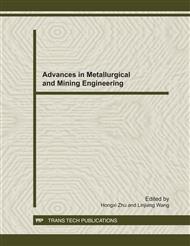p.96
p.100
p.107
p.111
p.116
p.123
p.132
p.138
p.142
Application of Simulated Annealing Algorithm in Sintering Burdening Optimization
Abstract:
Sintering burdening optimization has great value in reducing sintering cost and improving sinter qualities. Considering the nonlinear relationship between the high temperature characteristic parameters of iron ores in sintering, this article introduces the simulated annealing algorithm into burdening calculation and establishes a mathematic model of sintering burdening optimization. The initial parameters in simulated annealing algorithm are determined through tentative experiments, including initial temperature, cooling function, annealing constant and the end condition. The model can effectively reduce sintering cost and improve sinter qualities in its practical use.
Info:
Periodical:
Pages:
116-122
Citation:
Online since:
November 2011
Authors:
Price:
Сopyright:
© 2012 Trans Tech Publications Ltd. All Rights Reserved
Share:
Citation:


